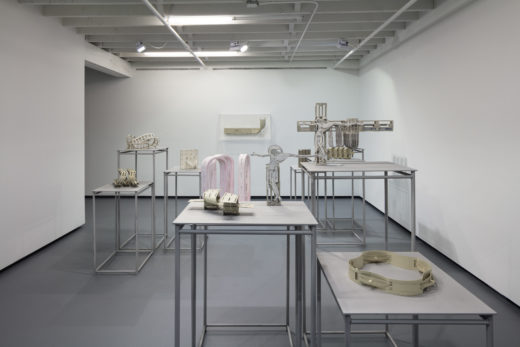Thomas Bayrle: One Day on Success Street
Erin Thurlow

Thomas Bayrle: One Day on Success Street, Institute of Contemporary Art, Miami.
NOVEMBER 29, 2016-MARCH 26, 2017
The Institute of Contemporary Art’s temporary home has created an opportunity for artists to engage with its striking atrium, which is buttressed with a three-dimensional grid of posts and beams, and extends through the height of the building. Given Thomas Bayrle’s career-spanning interest in structural systems, the site is a gift. Wire Madonna (2016), created in Miami by local fabricators, is for Bayrle both an uncharacteristic and typical gesture: a towering, three-story volumetric Pieta, “drawn” in space out of black tubular steel that weaves in and out of the building’s supports.
Curated by ICA’s Deputy Director and Chief Curator Alex Gartenfeld and Assistant Curator Stephanie Seidel, the show surveys nearly a half-century of output by an artist who is only recently being given full recognition, and should be a revelation to those unfamiliar with his work.
Bayrle mines a vein not far from the Pop Art of Hollywood-cool Andy Warhol and groovy, didactic Öyvind Fahlström, both of whom also bent toward the Post-Minimalists and the Conceptualists. He has worked across several mediums while rigorously maintaining a handcrafted, copy-cut-and-paste ethos that perfectly portrays, critiques, and meshes with the digital Photoshop universe his work increasingly inhabits. The painting Gotischer Schinken (Gothic Daub, 1980/84), hung at the show’s entry, illustrates tangles of impossibly dense, endless motorways. The vascular linguini of traffic arterials ironically echoes midcentury Abstract Expressionist brushwork, linking those commodified bodily gestures with systems of the megapolis. In the context of the show, such allegories serve to introduce visitors to themes that run through the artist’s entire oeuvre. Similar all-over works, produced decades earlier, were inspired by a weaving apprenticeship, where the artist worked with punch card-operated Jacquard looms. Wallpaper treatments that endlessly repeat images of people walking in public spaces are installed on various walls throughout the galleries.
Highway cloverleaf sculptures in the form of hollow bands of cardboard covered in miniature automobiles are also woven together into various forms. Their construction and scale recall architectural modeling, the civic planning of system design. They are nearly representations of factory conveyer belts as much as Autobahns. The visible interior of these arteries points to concepts of the body, and they often form religious symbols or monetary signs—the yuan, the dollar, and the deutschmark—lest we forget our symbolic language is built into our infrastructure.
Bayrle’s signature technique of constructing an iconic image out of smaller pictorial multiples, a gesture that foreshadows digitalization and the atomization of all visual information into the pixel, eventually leads to Atari Faces (1990–91), portraits made using early computer imaging technology. A wall text adjacent to these works explains that they maintain the tension between mechanical and manual reproduction due to the laborious programming required in their production. There are variations across all these works, but each is characterized by a conflation of the multitude or the multiple with a singularity. Carlos I, Carlos II, and Carlos III (1977) superimpose the face of the Venezuelan terrorist Ilyich Ramírez Sánchez, or Carlos the Jackal, onto a cityscape, taking note of a new social convulsion: an individual who is an inseparable part of the system that he seeks to destroy. This seems to contain the thrust of Bayrle’s artistic stance and worldview. Everything is a negotiation, often violent, between the individual and the collective state or corporation.
Bayrle’s skeptically humanist art is a sophisticated investigation of the nexus of the body and technology, and of the tension between the individual and socializing structures that have developed to connect us in global networks of info-commerce. At times, it can come off as over-determined; his techno-psychedelic style clearly owes a debt to the popular artworks of M. C. Escher. Works that incorporate sexual imagery and religious iconography can be reductively illustrative and corny. But his inventiveness and clarity of vision demonstrated by rigorous consistency is undeniable. In the ironic postmodern, overly contrived work can reinforce a sense of artifice, but—as it does here—it can inversely indicate that the author is sincere, authentic, and perhaps even unique.
Erin Thurlow is an artist, writer, and teacher residing in Miami.










